The Painter
An
inscription of the second century B.C. in the Ramgarh (Jogimara) cave, in early
characters, is the earliest to refer to a painter. It mentions a rupataka and
his sweetheart an adept in dance. As art permeated life in ancient India, every
young man and woman of taste had a knowledge of art, dance and music as
essential factors of literary aesthetic education. The non-professional
artists, with enough knowledge adequately to appreciate art trends in the
country, were in abundance and judged the art of the professionals.
The
fine arts were cultivated as a pastime, vinodasthana; and painting, being an
easier medium than modelling and sculpture, was probably more readily
preferred. The Kamasutra mentions painting as one of the several arts cultivated
by a nagaraka, a gentleman of taste. His chamber should have a lute (vina)
hanging by a peg on the wall, a painting board (chitraphalaka), a casket full
of brushes (vartikasamudgaka), a beautiful illuminated manuscript and
sweet-smelling flower garlands. The chitrakara was a professional artist of
eminence. Inferior craftsmen were known as dindins. The Uttararamacharita
refers to a chitrakara named Arjuna who had painted the murals illustrating the
life of Rama in the palace. The architects, artists and painters who had
decorated the royal palace on the eve of the marriage of princesss Rajyasri
were shown great respect as recorded in the Harshacharita. This shows the high
esteem in which they were held. When they were commissioned to do some work, they
were honoured before they started on it. From the Kathasaritsagara, we learn
that a painter enjoyed ten villages as a gift from the king. The chitrakaras,
along with sculptors, jewellers, goldsmiths, wood-carvers, metal crafts-men and
others, had an allocation of seats in the assembly of poets and scholars
convened in the royal court, as described by Rajasekhara in his Kavyamimamsa.
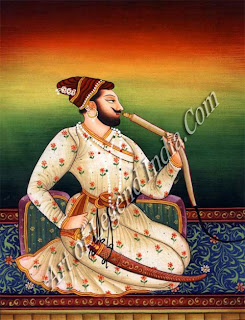 Distinguished
masters were specially honoured and invited to give their opinion on the
aesthetic value of works of art. These chitravidyopadhyayas were well-versed in
several branches of art. Encyclopedic knowledge of masters in architecture,
sculpture and painting and other allied branches is gathered from several
inscriptions. One of the best known among these is from Pattadakal, where the
silpi from the southern region, specially invited by king Vikramaditya to build
the Virupaksha temple, describes himself as an adept in every branch of art. A
scribe, who was a contemporary of the Western Chalukya king, Vikramaditya VI, boasts
of his skill in arranging beautiful letters in artistic form, entwining into
them shapes of birds and animals. The queen who enters the chitrasala, as
described in the Malavikagnimitra, intently gazes at the newly-painted
pictures, representing the harem with its retinue; and this being the work of a
master, and naturally compels her admiration. According to the
Vidhasalabhanjika, the queen's nephew, occasionally dressed in feminine attire,
is mistaken by painters (chitrakaras) to be a girl and represented thus almost
life-like on the palace walls, causing the king to mistake him for a girl.
Royal courts were frequented by numerous chitrakaras, as we gather from several
references; and an interesting instance is that of a painter who prepared an
exceedingly beautiful picture of a princess to demonstrate his skill in the
royal court. The Kathasaritsagara mentions one Kumaradatta as a gifted painter
at the court of king Prithvirupa of Pratishthana. The same text mentions
another famous painter, Roladeva from Vidarbha. Sivasvamin, a respectable
chitracharya, and an adept in painting is described as the lover of a courtesan
in the Padataditaka. Painters frequently visited Vesavasas and had naive
companions in natas, nartakas and vitas, vesyas and kuttanis. This indicates
their social position, which was not very high, though their art was
appreciated at the highest level. The high ideal of vinodastluma for art
amongst the nagarakas was just the opposite in the case of the courtesan, who
also learned art, neither as a professional nor as an amateur, but as one to
brandish her proficiency in fine arts to attract suitors, and to flourish in
her profession, as Damodaragupta portrays in his Kuttanimata. The morals of the
silpi class of his time are the subject of Kshemendra's interesting lampoon.
Distinguished
masters were specially honoured and invited to give their opinion on the
aesthetic value of works of art. These chitravidyopadhyayas were well-versed in
several branches of art. Encyclopedic knowledge of masters in architecture,
sculpture and painting and other allied branches is gathered from several
inscriptions. One of the best known among these is from Pattadakal, where the
silpi from the southern region, specially invited by king Vikramaditya to build
the Virupaksha temple, describes himself as an adept in every branch of art. A
scribe, who was a contemporary of the Western Chalukya king, Vikramaditya VI, boasts
of his skill in arranging beautiful letters in artistic form, entwining into
them shapes of birds and animals. The queen who enters the chitrasala, as
described in the Malavikagnimitra, intently gazes at the newly-painted
pictures, representing the harem with its retinue; and this being the work of a
master, and naturally compels her admiration. According to the
Vidhasalabhanjika, the queen's nephew, occasionally dressed in feminine attire,
is mistaken by painters (chitrakaras) to be a girl and represented thus almost
life-like on the palace walls, causing the king to mistake him for a girl.
Royal courts were frequented by numerous chitrakaras, as we gather from several
references; and an interesting instance is that of a painter who prepared an
exceedingly beautiful picture of a princess to demonstrate his skill in the
royal court. The Kathasaritsagara mentions one Kumaradatta as a gifted painter
at the court of king Prithvirupa of Pratishthana. The same text mentions
another famous painter, Roladeva from Vidarbha. Sivasvamin, a respectable
chitracharya, and an adept in painting is described as the lover of a courtesan
in the Padataditaka. Painters frequently visited Vesavasas and had naive
companions in natas, nartakas and vitas, vesyas and kuttanis. This indicates
their social position, which was not very high, though their art was
appreciated at the highest level. The high ideal of vinodastluma for art
amongst the nagarakas was just the opposite in the case of the courtesan, who
also learned art, neither as a professional nor as an amateur, but as one to
brandish her proficiency in fine arts to attract suitors, and to flourish in
her profession, as Damodaragupta portrays in his Kuttanimata. The morals of the
silpi class of his time are the subject of Kshemendra's interesting lampoon.
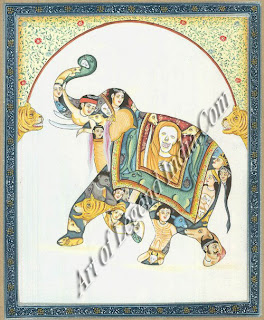
The
proficient artist, with hastochchaya or a good hand in producing pictures,
still commanded respect for his distinction in his field. The dindins, inferior
artists of mediocre taste, were in contrast to the chitracharyas, reputed for
their hastochchaya. Usually employed to repair old pictures, carvings and
flags, the dindins very nearly ruined them; it is no wonder that the
Padataditaka considers them to be not very different from monkeys dindino hi
namaite nativiprakrishta vanarebhyah. They are notorious for ruining pictures
by touching them up and for darkening the original lustre of colours by dabbing
with their brushes, alekhyam atmalipibhir gamayanti nasam saudheshu
kurchalcamashimalam arpayanti.
Colours,
prepared by the artist himself, as they occurred to his taste, were carried
along with the brushes in boxes, satnudgakas, gourds, alabus, specially
prepared for the purpose. Paintings on cloth were carefully preserved in silken
covers, in which they were rolled and kept. A beautiful picture is given of the
painter at work in the Mrichchhakatika, surrounded by a large number of colour
pans, from which he would just take a little from each, to put it on the
canvas, yo narnaham tatrabhavatas charudattasya riddhyahoratram prayatnasiddair
uddamasurabhigandhibhir modakair eva asitabhyantarachatussalakadvara upavishto
mallakasataparivrita chitrakara ivangulibhis sprishtva sprishtvapanayami. The
artist was alert to recognise a good picture when he achieved it, and even while
painting would nod his head in joyous approbation.
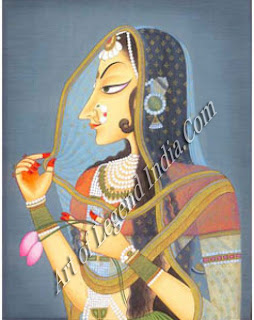 This
special trait of the painter has been noted by Valmiki, Harshavardhana,
Sriharsha, Kshemendra, Hemachandra and others. Passages like vikshya yam bahu
dhuvan siro jaravataki vidhirakalpi silpirat from the Naishadhiyacharita (XIII,
12) or yayau vilolayan maulim rupatisayavismitah in the Brihatkathamanjari (IX,
1121), or siramsi chalitani vismayavasad dhruvam vedhaso vidhyaya lalanam
jagattrayalalamabhutainimam from the Ratnavali (Act II, 41) amply illustrate
this.
This
special trait of the painter has been noted by Valmiki, Harshavardhana,
Sriharsha, Kshemendra, Hemachandra and others. Passages like vikshya yam bahu
dhuvan siro jaravataki vidhirakalpi silpirat from the Naishadhiyacharita (XIII,
12) or yayau vilolayan maulim rupatisayavismitah in the Brihatkathamanjari (IX,
1121), or siramsi chalitani vismayavasad dhruvam vedhaso vidhyaya lalanam
jagattrayalalamabhutainimam from the Ratnavali (Act II, 41) amply illustrate
this.
This
did not, however, mean any pride or self-appreciation. Painters in ancient
India, as we know had the humility to invite and accept criticism. In fact, the
Tilakamanjari refers to connoisseurs invited to appraise pictures tadasya kuru kalasastrakusalasya
kausalikam and kumara asti kinchid darsanayogyarn atra chitra pate, udbhutotra
pate kopi dosho va natimatram pratibhati.
It was
always a great joy for the painter to fashion the pictures with his own hand,
and he tried and did his best. His experimental sketches were known as
hastalekhas. Such preliminary sketches are often mentioned in literature. The
term varnaka connotes a final hastalekha, comparable to the determinant sketch
mentioned by Ruskin.
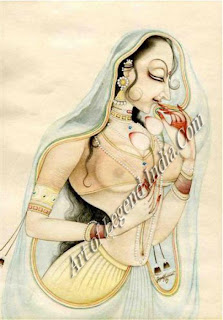
Passages
in literature help us to understand various stages in painting a picture, such
as the preparation of the ground, the drawing of the sketches, technically
known as rekhapradana or chitrasutradana, almost measured out on the board,
filling with colours, modelling through the three modes of vartanas and so
forth. The final addition of touches to make the picture live is the chit
ronmilana or the infusing of life into it. A well-known maxim is based on this
chitronmilana. Kalidasa compares the charm of Parvati to a picture infused with
life by unmilana, unmilotam tulikayeva chitram (Kumarasanibhava, I, 32). This
is the final process of painting the eyes of the figure by the painter when all
the rest is complete. Even today, this is a living tradition amongst the
hereditary craftsmen in India and Ceylon, who observe this in a solemn
ceremony.
Several
references provide an interesting picture of the habits of artists. Kshemendra
calls them kalachoras, thieves of time, since they usually delay their work
though anxious to receive their wages in time. The artist, however, was ever
aware of the superiority of his art, and when an occasion required it, he could
rise equal to it and prove his worth. A special method was in vogue to
challenge other painters in royal courts. A renowned painter, approaching the
palace gate, would put up a flag aloft, with his challenge painted on it,
asking anyone who accepted the challenge to pull it down. This was the prelude
to a contest in the court, decision by the ruler, and honour to the victor.
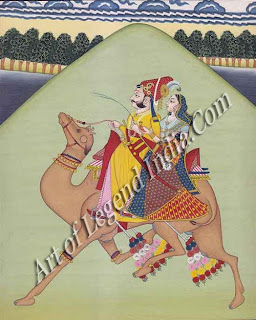 The
Indian painter, like the sculptor, usually dedicated himself to his art. He
made it an offering to the divine spirit and personally obscured himself. The
result has been that most names of artists in India are lost in oblivion. In
the Saundaryalahari, Sankara mentions even silpa as pujavidhana or a path of
worship. How a picture is to be prepared in the orthodox mode is illustrated in
the Vishnudharmottara, that requires the painter to sit devoted, facing east,
and offer prayers before commencing his work.
The
Indian painter, like the sculptor, usually dedicated himself to his art. He
made it an offering to the divine spirit and personally obscured himself. The
result has been that most names of artists in India are lost in oblivion. In
the Saundaryalahari, Sankara mentions even silpa as pujavidhana or a path of
worship. How a picture is to be prepared in the orthodox mode is illustrated in
the Vishnudharmottara, that requires the painter to sit devoted, facing east,
and offer prayers before commencing his work.
The
picture is believed always to reflect the mental and physical state of the
chitrakara. The Visimudharmottara mentions anyachittata, or absentmindedness,
as one of the causes that ruin the formation of a good picture. A common belief
mentioned in the Viddhasalabhanjilca is that a picture generally reflects the
merits of the artist even as a literary work does those of the poet in its
excellence, evam etat, yato garishthagoshthishvapyevam, kila struyate yadrisas
chit rakaras tadrishe chit rakarmaruparekha, yadrishah kavis tadrise
kavabandhachchhaya. The same is repeated in the Kavyamimamsa-sa yatsvabhavah
kavistadrisarupam kavyam, yadrisakaras chitrakaras tadrisakaram asya chitramiti
prayaso vadah.
Writer - C.SIVARAMAMURTI
 Distinguished
masters were specially honoured and invited to give their opinion on the
aesthetic value of works of art. These chitravidyopadhyayas were well-versed in
several branches of art. Encyclopedic knowledge of masters in architecture,
sculpture and painting and other allied branches is gathered from several
inscriptions. One of the best known among these is from Pattadakal, where the
silpi from the southern region, specially invited by king Vikramaditya to build
the Virupaksha temple, describes himself as an adept in every branch of art. A
scribe, who was a contemporary of the Western Chalukya king, Vikramaditya VI, boasts
of his skill in arranging beautiful letters in artistic form, entwining into
them shapes of birds and animals. The queen who enters the chitrasala, as
described in the Malavikagnimitra, intently gazes at the newly-painted
pictures, representing the harem with its retinue; and this being the work of a
master, and naturally compels her admiration. According to the
Vidhasalabhanjika, the queen's nephew, occasionally dressed in feminine attire,
is mistaken by painters (chitrakaras) to be a girl and represented thus almost
life-like on the palace walls, causing the king to mistake him for a girl.
Royal courts were frequented by numerous chitrakaras, as we gather from several
references; and an interesting instance is that of a painter who prepared an
exceedingly beautiful picture of a princess to demonstrate his skill in the
royal court. The Kathasaritsagara mentions one Kumaradatta as a gifted painter
at the court of king Prithvirupa of Pratishthana. The same text mentions
another famous painter, Roladeva from Vidarbha. Sivasvamin, a respectable
chitracharya, and an adept in painting is described as the lover of a courtesan
in the Padataditaka. Painters frequently visited Vesavasas and had naive
companions in natas, nartakas and vitas, vesyas and kuttanis. This indicates
their social position, which was not very high, though their art was
appreciated at the highest level. The high ideal of vinodastluma for art
amongst the nagarakas was just the opposite in the case of the courtesan, who
also learned art, neither as a professional nor as an amateur, but as one to
brandish her proficiency in fine arts to attract suitors, and to flourish in
her profession, as Damodaragupta portrays in his Kuttanimata. The morals of the
silpi class of his time are the subject of Kshemendra's interesting lampoon.
Distinguished
masters were specially honoured and invited to give their opinion on the
aesthetic value of works of art. These chitravidyopadhyayas were well-versed in
several branches of art. Encyclopedic knowledge of masters in architecture,
sculpture and painting and other allied branches is gathered from several
inscriptions. One of the best known among these is from Pattadakal, where the
silpi from the southern region, specially invited by king Vikramaditya to build
the Virupaksha temple, describes himself as an adept in every branch of art. A
scribe, who was a contemporary of the Western Chalukya king, Vikramaditya VI, boasts
of his skill in arranging beautiful letters in artistic form, entwining into
them shapes of birds and animals. The queen who enters the chitrasala, as
described in the Malavikagnimitra, intently gazes at the newly-painted
pictures, representing the harem with its retinue; and this being the work of a
master, and naturally compels her admiration. According to the
Vidhasalabhanjika, the queen's nephew, occasionally dressed in feminine attire,
is mistaken by painters (chitrakaras) to be a girl and represented thus almost
life-like on the palace walls, causing the king to mistake him for a girl.
Royal courts were frequented by numerous chitrakaras, as we gather from several
references; and an interesting instance is that of a painter who prepared an
exceedingly beautiful picture of a princess to demonstrate his skill in the
royal court. The Kathasaritsagara mentions one Kumaradatta as a gifted painter
at the court of king Prithvirupa of Pratishthana. The same text mentions
another famous painter, Roladeva from Vidarbha. Sivasvamin, a respectable
chitracharya, and an adept in painting is described as the lover of a courtesan
in the Padataditaka. Painters frequently visited Vesavasas and had naive
companions in natas, nartakas and vitas, vesyas and kuttanis. This indicates
their social position, which was not very high, though their art was
appreciated at the highest level. The high ideal of vinodastluma for art
amongst the nagarakas was just the opposite in the case of the courtesan, who
also learned art, neither as a professional nor as an amateur, but as one to
brandish her proficiency in fine arts to attract suitors, and to flourish in
her profession, as Damodaragupta portrays in his Kuttanimata. The morals of the
silpi class of his time are the subject of Kshemendra's interesting lampoon.  This
special trait of the painter has been noted by Valmiki, Harshavardhana,
Sriharsha, Kshemendra, Hemachandra and others. Passages like vikshya yam bahu
dhuvan siro jaravataki vidhirakalpi silpirat from the Naishadhiyacharita (XIII,
12) or yayau vilolayan maulim rupatisayavismitah in the Brihatkathamanjari (IX,
1121), or siramsi chalitani vismayavasad dhruvam vedhaso vidhyaya lalanam
jagattrayalalamabhutainimam from the Ratnavali (Act II, 41) amply illustrate
this.
This
special trait of the painter has been noted by Valmiki, Harshavardhana,
Sriharsha, Kshemendra, Hemachandra and others. Passages like vikshya yam bahu
dhuvan siro jaravataki vidhirakalpi silpirat from the Naishadhiyacharita (XIII,
12) or yayau vilolayan maulim rupatisayavismitah in the Brihatkathamanjari (IX,
1121), or siramsi chalitani vismayavasad dhruvam vedhaso vidhyaya lalanam
jagattrayalalamabhutainimam from the Ratnavali (Act II, 41) amply illustrate
this.  The
Indian painter, like the sculptor, usually dedicated himself to his art. He
made it an offering to the divine spirit and personally obscured himself. The
result has been that most names of artists in India are lost in oblivion. In
the Saundaryalahari, Sankara mentions even silpa as pujavidhana or a path of
worship. How a picture is to be prepared in the orthodox mode is illustrated in
the Vishnudharmottara, that requires the painter to sit devoted, facing east,
and offer prayers before commencing his work.
The
Indian painter, like the sculptor, usually dedicated himself to his art. He
made it an offering to the divine spirit and personally obscured himself. The
result has been that most names of artists in India are lost in oblivion. In
the Saundaryalahari, Sankara mentions even silpa as pujavidhana or a path of
worship. How a picture is to be prepared in the orthodox mode is illustrated in
the Vishnudharmottara, that requires the painter to sit devoted, facing east,
and offer prayers before commencing his work.
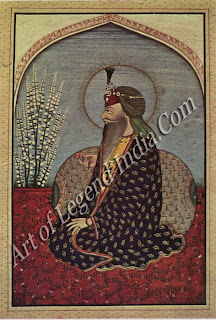












0 Response to "Indian Painting - The Painter"
Post a Comment